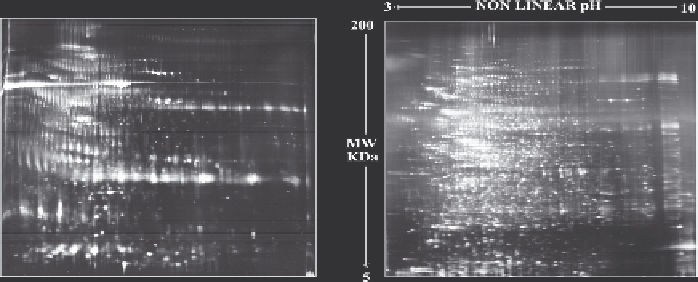Biology Reference
In-Depth Information
the technology for the discovery of biomarkers.
46
The authors indicated that the use of the sample
process followed by 2D-DIGE analysis enabled
detection of many new protein spots along
with increased resolution improved intensity
for low-abundance protein discovery. It has
been reported that the reproducibility was
good enough to suggest a successful integration
of the bead technology to deliver new protein
biomarker candidates.
Other comparative proteomics approaches
also evidenced differences between protein
patterns from different samples, a sort of marker
of difference that may not be necessarily linked to
pathology. Such was the case with the in
serpin proteinase inhibitor, along with the secre-
tory form of clusterin. In addition, protein
fragments from the proteolysis of several well-
identi
rming a time-
dependence of the degradation phenomenon.
The discovery of undetectable dilute proteins
is dependent on the capability to elute all
captured proteins by the CPLL beads. However,
the eluting agents can be deleterious to the
protein integrity and would have to be selected
according to the following analytical methods.
It has recently been demonstrated that unor-
thodox elution methods such as mixtures of
amino acids are very powerful to desorb quanti-
tatively urinary proteins (
Figure 5
) in almost
physiological conditions, thus avoiding the
noxious presence of SDS, especially for
ELISA-based assays and IEF analyses.
58
This
approach opens many possibilities in investiga-
tions devoted to expression differences.
All of the above examples prove the signifi-
ed species were found con
uence
of room temperature storage of platelets buffy
coats.
57
The analysis of this biological material
was performed by 2-DE coupled to mass spec-
trometry before and after CPLL treatment.
Upon storage, differences were discovered in
low-abundance proteins such as accumulation
of certain proteins coming from progressive loss
of platelet integrity, suggesting that this enrich-
ment process could be advantageously used for
the determination of the quality of biological
therapeutic products. Few proteins representative
of platelet degeneration were found, such
as alpha-1-beta-glycoprotein, kininogen-1, and
-
cant developments expected from the associa-
tion of sample treatment with CPLL and 2-DE
analysis for both low-abundance protein detec-
tion and the identi
c groups of
proteins such as allergens and identi
cation of speci
cation of
potential diagnostic markers.
Figure 4
schemati-
cally illustrates these two routes.
(A)
(B)
FIGURE 4
2-DE maps of (A) control urines and (B) urines after CPLL capture and elution with a mixture of Arg, Lys, Asp,
and Glu in 2:2:1:1 molar ratios. Whereas in (A) barely 600 spots can be counted, in (B) 3,300 protein spots could be visualized.
Silver stain. (Candiano et al., unpublished).


Search WWH ::

Custom Search